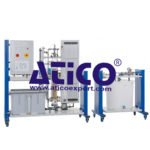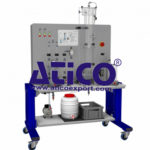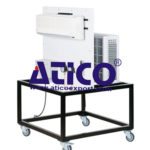As well as its great importance for the chemical and foodstuffs industries, ethanol (alcohol) is increasingly used as a fuel. The can be used to conduct realistic experiments for the production of ethanol from starch-based raw materials such as potatoes. The experimental plant consists of three main components: a mash tank, a fermentation tank and a distillation unit.
A mixture of water, finely chopped potatoes and alpha-amylase (enzyme) is filled into the mash tank. To dissolve the tightly packed starch chains in the potatoes, heating steam is injected into the mixture via a nozzle (gelatinisation). This increases the flow resistance of the mash, which would prevent further processes. The alpha-amylase breaks up the starch chains (liquefying) thereby reducing the flow resistance.
Learning Objectives/Experiments
- Familiarization with the necessary individual steps and system components for production of ethanol:
- Gelatinisation by steam injection
- Liquefaction by use of alpha-amylase
- Saccharification by use of gluco-amylase
- Fermentation: conversion of sugar into ethanol by yeast cultures under anaerobic conditions
- Distillation: separation of ethanol from the mash
Specification
- Batch conversion of starch-based raw materials into ethanol
- Open mash tank with water-jacket cooling, steam injection and stirrer
- Closed fermentation tank with stirrer and water-jacket cooling/heating
- Distillation unit with 3 bubble cap trays, dephlegmator, condenser and stirrer
- 2 pumps for delivering the mash
- pH value control in the mash tank with acid and caustic delivered by metering pumps
- Adjustment of the amount of injected heating steam, the cooling water flow rates and the head Temperature by means of PID controllers
- System control using a PLC; operated by touch screen
Technical Data
- Mash tank: 40L
- Fermentation tank: 50L
- Product tank: 10L
- Spent mash: 30L
- Distillation unit
- column: DxH: 220x1200mm
- sump capacity: 45L
- sump heater: 0…7500W
- 2 air-operated diaphragm pumps
- drive pressure: 2bar
- max. flow rate: 15L/min
- max. head: 20m
- max. solid lump size: 4mm
- 2 metering pumps (acid and caustic)
- max. flow rate: each 2,1L/h
- Measuring ranges
- temperature: 10x 0…150°C
- flow rate: 0…25L/min (to mash tank)
- pH value: 2…10
- pressure: 0…10bar (steam)
- 400V, 50Hz, 3 phases
- 400V, 60Hz, 3 phases; 230V, 60Hz, 3 phases






